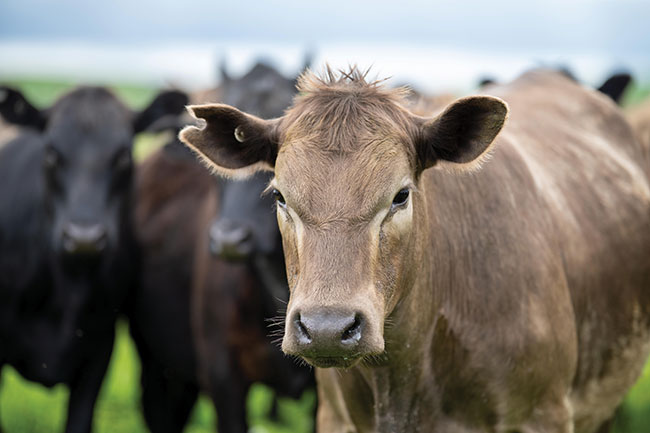
Features
Environment Research
Research
A new model
Quantifying emissions through volatile solid output.
June 1, 2023 by Richard Kamchen
 Farmers in various states and provinces are under pressure to reduce emissions, with many
scrutinizing the dairy industry in particular.
Photo: © Phoebe / adobe stock
Farmers in various states and provinces are under pressure to reduce emissions, with many
scrutinizing the dairy industry in particular.
Photo: © Phoebe / adobe stock A collaborative study has found models that could benefit farmers, especially as governments’ greenhouse gas (GHG) reduction strategies take aim at sectors such as agriculture.
Livestock manure management systems (MMS) are major GHG sources, especially in industrialized livestock farming regions. Methane (CH4) is the main GHG emitted, particularly from liquid-based MMS.
MMS, common in North America, makes CH4 from MMS a chief target of governments seeking to mitigate GHG emissions from agriculture, according to the study, a collaboration between Iowa State University (ISU), University of California-Davis, and University of Guelph.
Quantifying CH4 emissions from MMS is important in establishing national inventories and assessing the effect of mitigation programs like anaerobic digestors, the study said. But because measuring CH4 emissions is expensive and labor-intensive, mathematical models may be a preferred method to predicting the emissions.
These models can prove very helpful and useful to farmers to efficiently evaluate their emission-reduction efforts.
When it comes to dairy cows, there are two sources of GHG: burps, or enteric methane emission, (meaning the methane is produced in the digestive track of the animal), and manure.
Volatile solids
Emissions from the manure can be estimated by using volatile solid (VS) output. VS is typically collected after excretion and stored in liquid or solid form until field application.
“We need to know the volatile solids in manure to predict CH4 emissions from manure,” says study lead Dr. Ranga Appuhamy, an assistant professor at ISU’s department of animal science.
Presently, Intergovernmental Panel on Climate Change (IPCC) Tier 2 methodology determines VS with a model requiring information such as gross energy (GE) intake and dietary energy digestibility, both of which aren’t typically available at commercial farms.
As a result, default constants or population averages are generally used for those variables. But constant values can considerably affect the accuracy of VS estimates because factors like DE are highly variable across diets, the study said.
The VS models can assist producers to determine GHG emissions from their dairy cows’ manure more efficiently rather than collecting and measuring total manure volume and sending it to labs for chemical composition analysis, Appuhamy says.
“This study offers a model that predicts VS output (kg/d) of individual cows by using organic matter intake of the cow (kg/d) and concentrations of fiber and protein in the diet. Therefore, the model can explain how diet impacts manure CH4 emissions,” he explains. “However, to determine organic matter intake, you need to know the dry matter intake (DMI) of individual cows.”
DMI
For equations predicting methane emissions of dairy cows, DMI is often the number-one variable because it drives the substrate availability for production of methane in the digestive tract or manure, says Appuhamy.
“Animals eating more dry matter will emit more methane,” he says. “That’s the main reason for the difference between the greater enteric methane emissions (g/d) of dairy cows compared to beef cattle, because dairy cows consume daily more feed than beef cows.”
The more they eat, the more feces they excrete.
But tracking the quantity of feed an individual cow consumes is challenging. It’s possible to make an estimate of the average DMI by calculating the feed delivered to a particular pen, subtracting what’s left over, and then dividing that by the number of animals in the pen. However, not every farm may have the capacity to come up with such estimates.
Therefore, this study uses a DMI prediction model including easily found variables on farms, such as milk yield and milk composition, Appuhamy says.
“Instead of actual observation, we may be able to use this estimated dry matter intake to plug into our model predicting volatile solid output of dairy cows,” he says.
VS model benefits
The study says new models could more accurately and efficiently predict VS output than the IPCC Tier 2 recommended methodology, which requires accurate estimation of energy digestibility of feed.
The predicted VS output will help determine efficiently the manure CH4 emission factors (kg/cow/year) for greenhouse gas inventories and biogas potential of biodigesters, Appuhamy says.
Another benefit to farmers is having a tool to evaluate some strategies aiming to mitigate CH4 emissions and thereby taking advantage of carbon market incentives, which pays farmers for mitigating emissions, he adds.
“The farmer can adapt different strategies to mitigate methane emissions, the methane emissions produced in the animal itself, or the methane emissions from the manure,” says Appuhamy.
Cows that produce more milk relative to DMI will have lower VS output, meaning their manure produces less methane per unit of milk.
“Those sustainable efforts will be evaluated, verified, and paid in the future (where available), and we need tools such as prediction models to perform those tasks efficiently,” says Appuhamy. •